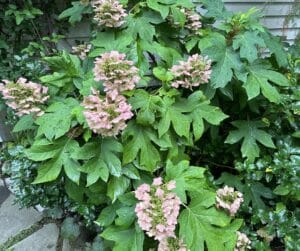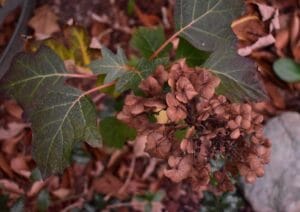Hello, fellow lovers of all things green. Bonnie of Stillwater, NJ, has a Burning Bush planted by her parents, who once lived in the home. She is attached to it and continues to prune it to keep it from rising above her bay window, which may help prevent its invasiveness. But I suggested she replace it with a native plant, highlighting the beauty and versatility of Oak Leaf Hydrangea for all seasons.

Oakleaf Hydrangea’s long-lasting bloom Garden design by Mary Stone / Photo and garden loved by Jacquie Larson
Oakleaf Hydrangeas are stunning in all seasons.
In the Fall, their husky oak-shaped leaves turn a mix of maroon and dark purple with bright red and bronze—some like Hydrangea quercifolia ‘Alice’ turn a florescent reddish burgundy, much like Burning Bush. Even after the leaves fall, Oakleaf Hydrangeas are lovely, with exfoliating bark and dried flowers to adorn the winter landscape. In the spring, you’ll enjoy the unfurling dark green leaves rising above the beautiful ginger-colored bark.
Oakleaf Hydrangeas are not fussy handling a wide range of soil, though they prefer slightly acidic. Still, they can tolerate alkaline soil, and the pH does not affect the blooms’ color. They also stand up to road salt and salt spray. Along with other hydrangea species, Rutgers University considers Oakleaf’s “C” in deer resistance – “Occasionally Severely Damaged.” However, they seem less tasty than their cousins with softer leaves.
Oakleaf Hydrangeas are fuss-free and flexible.
They bloom white for six to eight weeks, beginning in June. Then, shift to pink to purplish-pink, depending on the species, before drying to a lovely brown. They are gorgeous in a winter garden when snow dons the flowers with fluffy white hats.
Hardy in zones 5 to 9, they can tolerate full sun here, unlike other hydrangeas. In warmer zones, they prefer morning sun and afternoon shade. One thing is for sure they do not like wet feet, and so well-drained soil is required. But they can tolerate occasional dryness, unlike others, though moist soil is preferred.
Hydrangea quercifolia is native to the Southeastern US, but native garden designs in the Northeast often feature them. The only officially native hydrangea to these parts is Smooth Hydrangea (H. arborescens), also called Wild Hydrangea. Unlike Smooth Hydrangea, which blooms on new wood, Oakleaf’s bloom on old wood, so only prune them before new flower buds are set to ensure flowers next year.
Garden Companions to Hydrangea quercifolia
The oak-shaped leaves offer a pleasing course texture to gardens. Fine-textured evergreen shrubs like Holly (Ilex) and Inkberry (Ilex glabra) make lovely neighbors. And companion perennials such as Pulmonaria (Lungwort) and Coral Bells (Heuchera) are beautiful in the foreground. There’s also Hosta, though deer candy, so deer spraying is in order.
Oakleaf Hydrangeas’ rustic appearance makes them ideal for woodland gardens or as specimens or informal hedges in more tailored gardens. There are many varieties of sizes to choose from.
There’s an Oakleaf Hydrangea to fit every space.

‘Munchkin’ Oak Leaf Hydrangea in summer sporting lovely freckles.
The straight species, Hydrangea quercifolia, grows relatively quickly to a stately 12 to 14 feet tall and wide. It is irregularly shaped and quickly spreads by suckering—pushing out vertical shoots at its base. But you can prune the runners to prevent spreading. Or, let them root and share volunteers with friends.
The readily available variety, ‘Alice’, is most like the straight species. But if you prefer a more tidy, less loose appearance, then ‘Snowflake’ is perfect for you. She grows 5 to 8 feet tall and has long, 12 to 15-inch double flowers (extra flower petals).
For a smaller garden space, ‘Ruby Slippers’ is one of my favorites, growing 3 to 4 feet. As its name describes, the white flowers shift to reddish-rose. Or there’s ‘Munchkin’ Oakleaf Hydrangea, whose flowers change to a lighter pink. Smaller still is a little beauty named ‘Pee Wee’ that I stumbled upon. I adore its petite 2 to 4-foot size.
Why it’s best to buy rather than pilfer :^)
I found a hilarious story about two galivanting gardeners harvesting native Oakleaf Hydrangeas off-road in precarious spots. Delirious with excitement over the value of their bounty, it wasn’t until the next day that they realized the extent of their injuries from rolling down slippery slopes, including cracked ribs and punctured lungs—a lesson to all of us to not steal from Mother Nature.
There are beautiful Norway spruces along the Appalachian Trail at Blue Mountain Lake, and I’ve often wanted to snag one as a Christmas tree. However, I never did because if I were arrested as a garden designer, that may be a problem (smile). As much as we admire plants along the road or in the woods, leave them be and buy them at your local nursery instead.
Garden Dilemmas? AskMaryStone@gmail.com (and your favorite Podcast App).
There’s more to the story in the Garden Dilemmas Podcast (a soothing 10 minutes):
Link to a previous column on When to Prune Hydrangea, Deer.
Here is a link to Darrell Norman’s hilarious story: Beware stalking the wild hydrangea.
More About invasive Burning Bush:
Euonymus alatus, also known as Winged Euonymus, was a popular shrub because of its brilliant red fall color. Introduced in the 1860s from Asia, it began inundating woodlands by the mid-1980s, landing it on invasive lists in over 20 states and banned in other states such as Pennsylvania, Massachusetts, and Minnesota. The discreet green flowers turn to berries that birds adore hence how the plant became invasive. So, rejuvenating by pruning Burning Bush by cutting off the flowers each June may help the seed spread. But the best thing to do is remove the plant and choose a more beautiful option, such as Oakleaf Hydrangea with beauty and versatility for all seasons.
Other Native Plants to Replace Burning Bush
Deer-resistant Common Ninebark (Physocarpus opulifolius) with cultivars such as ‘Ginger Wine’ emerge orange in spring, then age to burgundy and brighten to red in Fall.
Although Aronia arbutifolia is not deer-resistant, Chokeberry is often a vase-shaped shrub with reddish-orange or purple leaves in the Fall. Its berries attract birds, and you can eat them, too.
And there’s Winterberry, which we discussed in Winter Beauty of Winterberry (and in Episode 142, Berries for Winter Beauty and Wildlife). I adore how the story wraps up with the legend of Winterberry when a hungry bear chooses to share the tiny morsel (one lone Winterberry), and because he did, “when the cold and freezing night, at last, came to an end, there were berries blooming everywhere!” The charming story of sharing despite shortages resulting in abundance is a lesson for all.



